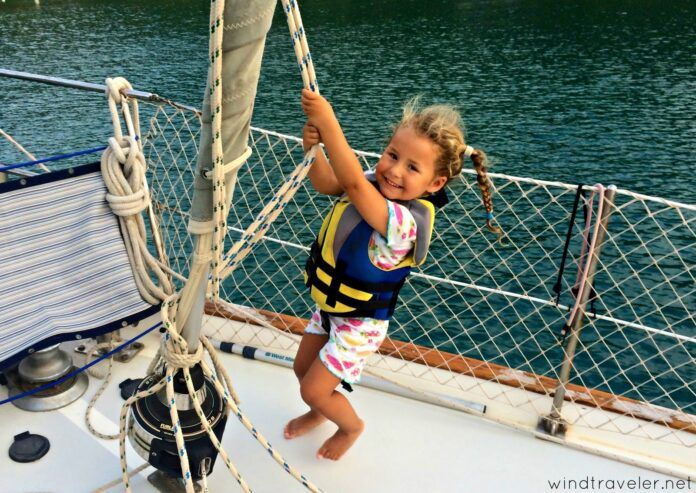Safety is always a priority on the water. When you add the unpredictable nature of kids to the mix, the stakes are even higher. What are the best ways to keep children safe on board? Here we’ll explore how you can enjoy your time on the water with the peace of mind that comes from essential products, techniques, and ideas for keeping your smallest crew members safe.
If you’ve ever seen a toddler stumbling around while learning her first steps, you know the feeling of imminent disaster. Most parents prepare for their baby’s first steps by creating a safe environment at home devoid of sharp corners and steps.
Now imagine that same toddler teetering around on the deck of a sailboat on the open water. Yikes!
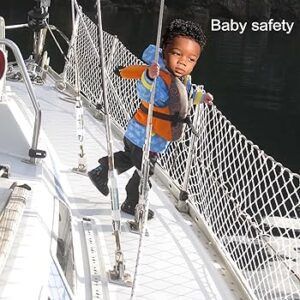
The combination of young kids and water can feel daunting. Still, the experiences of sailing a boat, visiting beaches, and spending time together as a family will build memories to last a lifetime. With the proper gear and guidance, you can create a safe environment for even your littlest sailors.
We’re assuming you’ve received CPR and First-Aid training. Adding these products and practices to those fundamentals will keep your anxiety at bay.
PERSONAL FLOTATION DEVICES
Consistently wearing a lifejacket is at the top of every list for boating safety. United States Federal law requires all children under 13 to wear a life jacket when a vessel is underway (unless they are belowdeck or within an enclosed cabin). Your state requirements may vary.
Finding the right life jacket for your child is the first step. Look for a jacket that matches your child’s age and weight and includes features like a “heads up” cushion for infants and grab handles at the back for toddlers. Ensure the vest comes with a crotch strap so your little one can’t slip out of it, and an attached whistle (we’ll cover that feature in more detail later).
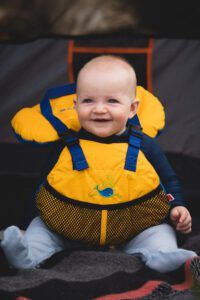
This infant vest won the Canadian Safe Boating Award (CASB) for Best New Safety Product. It features a bright color for easy visibility, a grab handle at the top, and smooth nylon fabric to reduce chafe.
Test any jacket’s fit by trying it on your child and snugly fitting the adjustable straps, especially the strap between the legs. Now, have your child raise his or her arms in the air while you lift from the top of the armholes. The child’s ears and chin should not slip below the vest. Keep trying on vests until you find one that passes this test, and bribe your child with ice cream as needed.
As we all know, children grow quickly. A vest that fits perfectly in April may not fit by August. While hand-me-downs might seem like a way to save some money, the proper fit is worth your peace of mind. Invest in the right vest for your child as they grow.
PHYSICAL SAFETY RESTRAINTS
Young children love to explore, and boats and water are the ideal playground for curious minds. While adult supervision on board is a 24/7 requirement, these products will help keep your charges safe.
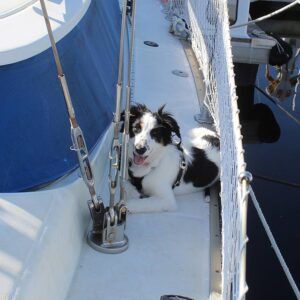
Lifeline netting is a strong, webbed material attached to the inside of the lifelines all the way around the deck and securely grounded at the toerail. This swath of netting keeps people, pets, and objects from sliding off the deck in unstable conditions. These nets have saved many dropped or abandoned toys from the drink, so your child will appreciate them, too.
Sailrite offers durable, twisted nylon twine with UV inhibitors available in a custom-length.
The company also offers a good video on lifeline net installation, available here. As you’ll see, give yourself plenty of free, uninterrupted time to get this done right. It’s not hard, but it is time-consuming.
Belowdeck, a boat’s motion can easily send a little one tumbling. Make sure any sharp corners have padding, and keep doors latched at all times.
Big seas bring the risk of kids falling out of berths. For infants and young children, a portable bed rail can provide a layer of protection. For a more permanent solution, you can craft a custom lee cloth. Lee cloths are strung across the inboard length of the berth and suspended vertically with removable snaps or ties. Made of mesh or fabric, they provide a soft barrier to prevent your child from tumbling to the cabin sole. Kids love a fort, and lee cloths create a fun space for your kids to keep toys and books.
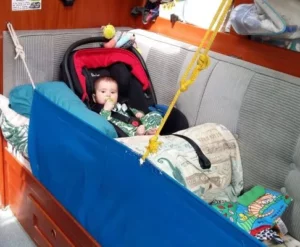
Sailrite provides excellent guidance on creating your own custom lee cloth. Be sure to read the comments regarding anchoring the fabric and the use of plastic buckles and snaps. Consider upgrading those components.
Portable cribs are also a great temporary solution if your cabin space allows it. The ability to bring the crib to your shoreside destination is a bonus.
PREPARATION
The best time to consider safety on board is well before you leave the dock. When we take kids out on a boat, we open up a new world for them to explore. Sailing should be fun, educational, and safe for everyone on board.
Before you set off, it’s a good idea to get down on your hands and knees and explore the boat from your child’s point of view. Look for sharp corners, wires, screws, or other small objects they could swallow or otherwise harm your child. Little ones are exceedingly clever at finding something you’ve missed, so exercise caution.
Water safety starts with introducing children to water and swimming at the earliest age. Infant swimming classes are widely available, and an early education in swimming makes for confident kids. Check your local resources for swimming lessons for all ages and experience levels.
In addition to the life-saving products covered earlier, it is crucial to establish safe behavior, rules, and “what-if” scenarios with your children.
- Involve your kids in learning about boating safety with games, quizzes on nautical terms, and role-playing activities.
- Practice “rough conditions” procedures with your kids. Teach your kids where to go when conditions are rough so they can stay safe, such as a vee-berth. Keep some soft toys handy in that location.
- Teach your child how to blow the whistle attached to their life vest to alert an adult if they fall overboard or experience other emergencies. Cover your ears and encourage your child that for once, louder is better! Teach young kids to become comfortable blowing loudly and consistently until an adult arrives.
- Repetition is the key to learning and developing new habits in young minds, so practice often and have fun.
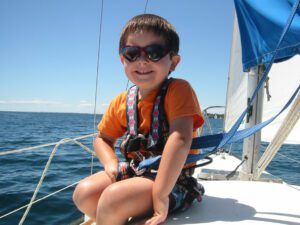
Like safety rules at home and the playground, establishing rules on board is not just important; it can be life-saving. Each family decides which rules work best for their vessel and situation; here are a few ideas to get you started.
- No touching switches or buttons
- No running on deck
- No leaving the cabin without an adult
- Remain seated while docking
- No leaning over the bow or over the lifelines.
Add new rules as appropriate; children have a way of finding work-arounds and vulnerabilities. Rules can be adapted as needed.
As your kids grow and become familiar with boating, you can allow them to help with tasks as long as they are being supervised. If you are in a tight situation docking or changing a sail and you can’t pay attention to the kids, put them below in their safe place. Encourage your kids to teach water safety to younger children and be a role model for safe behavior. If you wear your PFD, they’ll wear theirs. Before long, your kids will be handling lines and tossing out fenders— while wearing a PFD, of course.
Sailing with children is an adventure and the experience of a lifetime. Armed with the proper gear and knowledge, you can relax and enjoy your family’s journey with peace of mind.
Have you found any safety gear that added a layer of reassurance to your vessel? Are there any best practices for safety that we missed? Let us know in the comments.


































